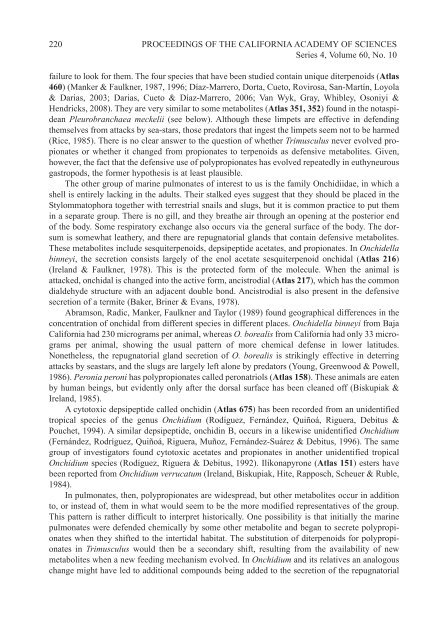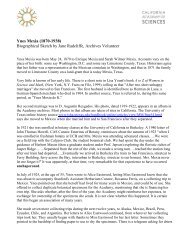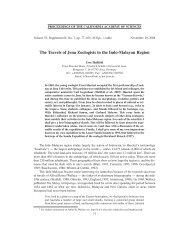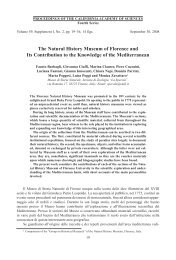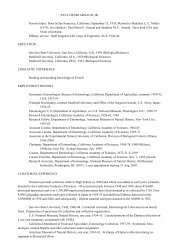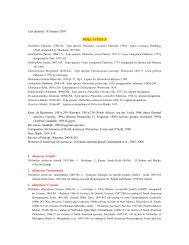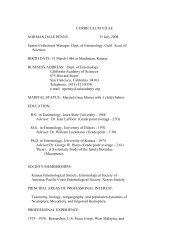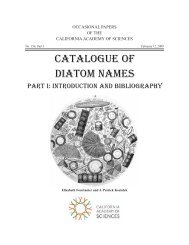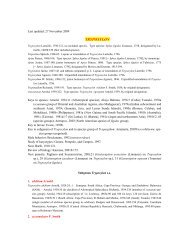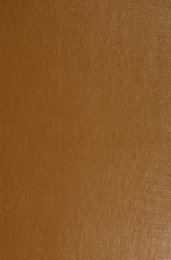Cimino&Ghiselin-tmpZXYZ:Template Proceedings_1.qxd.qxd
Cimino&Ghiselin-tmpZXYZ:Template Proceedings_1.qxd.qxd
Cimino&Ghiselin-tmpZXYZ:Template Proceedings_1.qxd.qxd
Create successful ePaper yourself
Turn your PDF publications into a flip-book with our unique Google optimized e-Paper software.
220 PROCEEDINGS OF THE CALIFORNIA ACADEMY OF SCIENCES<br />
Series 4, Volume 60, No. 10<br />
failure to look for them. The four species that have been studied contain unique diterpenoids (Atlas<br />
460) (Manker & Faulkner, 1987, 1996; Díaz-Marrero, Dorta, Cueto, Rovirosa, San-Martín, Loyola<br />
& Darias, 2003; Darias, Cueto & Díaz-Marrero, 2006; Van Wyk, Gray, Whibley, Osoniyi &<br />
Hendricks, 2008). They are very similar to some metabolites (Atlas 351, 352) found in the notaspidean<br />
Pleurobranchaea meckelii (see below). Although these limpets are effective in defending<br />
themselves from attacks by sea-stars, those predators that ingest the limpets seem not to be harmed<br />
(Rice, 1985). There is no clear answer to the question of whether Trimusculus never evolved propionates<br />
or whether it changed from propionates to terpenoids as defensive metabolites. Given,<br />
however, the fact that the defensive use of polypropionates has evolved repeatedly in euthyneurous<br />
gastropods, the former hypothesis is at least plausible.<br />
The other group of marine pulmonates of interest to us is the family Onchidiidae, in which a<br />
shell is entirely lacking in the adults. Their stalked eyes suggest that they should be placed in the<br />
Stylommatophora together with terrestrial snails and slugs, but it is common practice to put them<br />
in a separate group. There is no gill, and they breathe air through an opening at the posterior end<br />
of the body. Some respiratory exchange also occurs via the general surface of the body. The dorsum<br />
is somewhat leathery, and there are repugnatorial glands that contain defensive metabolites.<br />
These metabolites include sesquiterpenoids, depsipeptide acetates, and propionates. In Onchidella<br />
binneyi, the secretion consists largely of the enol acetate sesquiterpenoid onchidal (Atlas 216)<br />
(Ireland & Faulkner, 1978). This is the protected form of the molecule. When the animal is<br />
attacked, onchidal is changed into the active form, ancistrodial (Atlas 217), which has the common<br />
dialdehyde structure with an adjacent double bond. Ancistrodial is also present in the defensive<br />
secretion of a termite (Baker, Briner & Evans, 1978).<br />
Abramson, Radic, Manker, Faulkner and Taylor (1989) found geographical differences in the<br />
concentration of onchidal from different species in different places. Onchidella binneyi from Baja<br />
California had 230 micrograms per animal, whereas O. borealis from California had only 33 micrograms<br />
per animal, showing the usual pattern of more chemical defense in lower latitudes.<br />
Nonetheless, the repugnatorial gland secretion of O. borealis is strikingly effective in deterring<br />
attacks by seastars, and the slugs are largely left alone by predators (Young, Greenwood & Powell,<br />
1986). Peronia peroni has polypropionates called peronatriols (Atlas 158). These animals are eaten<br />
by human beings, but evidently only after the dorsal surface has been cleaned off (Biskupiak &<br />
Ireland, 1985).<br />
A cytotoxic depsipeptide called onchidin (Atlas 675) has been recorded from an unidentified<br />
tropical species of the genus Onchidium (Rodíguez, Fernández, Quiñoá, Riguera, Debitus &<br />
Pouchet, 1994). A similar depsipeptide, onchidin B, occurs in a likewise unidentified Onchidium<br />
(Fernández, Rodríguez, Quiñoá, Riguera, Muñoz, Fernández-Suárez & Debitus, 1996). The same<br />
group of investigators found cytotoxic acetates and propionates in another unidentified tropical<br />
Onchidium species (Rodíguez, Riguera & Debitus, 1992). Ilikonapyrone (Atlas 151) esters have<br />
been reported from Onchidium verrucatum (Ireland, Biskupiak, Hite, Rapposch, Scheuer & Ruble,<br />
1984).<br />
In pulmonates, then, polypropionates are widespread, but other metabolites occur in addition<br />
to, or instead of, them in what would seem to be the more modified representatives of the group.<br />
This pattern is rather difficult to interpret historically. One possibility is that initially the marine<br />
pulmonates were defended chemically by some other metabolite and began to secrete polypropionates<br />
when they shifted to the intertidal habitat. The substitution of diterpenoids for polypropionates<br />
in Trimusculus would then be a secondary shift, resulting from the availability of new<br />
metabolites when a new feeding mechanism evolved. In Onchidium and its relatives an analogous<br />
change might have led to additional compounds being added to the secretion of the repugnatorial


